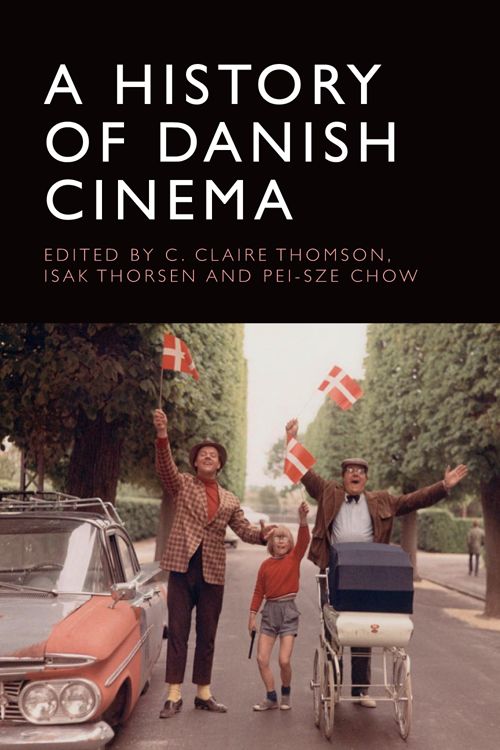
A History of Danish Cinema edited by C. Claire Thomson, Isak Thorsen, and Pei-Sze Chow
 A History of Danish Cinema features twenty-one essays and is the first work on this topic in the English language. The remit of this book—as laid out in its robust introduction—is to synthesize and adapt the existing Danish-language film scholarship, to gently confirm or dismiss any preconceptions that the reader may have, and ultimately to lay a solid basis for future contributions to the topic in English. Given the long and varied history of the Danish film industry—a national cinema that has historically been seen as successful on the world stage—the book succeeds in maintaining a coherent register across its contributors and in fleshing out a number of recurrent central themes. We must also acknowledge some of the quietly effective ways in which A History of Danish Cinema establishes itself as a valuable pedagogical tool, even if it is unlikely to inspire any genuinely impassioned response. Coming in the midst of a fractious culture war that has divided Denmark through stringent notions of national identity and defective canon formations, this work is refreshingly civil and self-aware in its approach.
A History of Danish Cinema features twenty-one essays and is the first work on this topic in the English language. The remit of this book—as laid out in its robust introduction—is to synthesize and adapt the existing Danish-language film scholarship, to gently confirm or dismiss any preconceptions that the reader may have, and ultimately to lay a solid basis for future contributions to the topic in English. Given the long and varied history of the Danish film industry—a national cinema that has historically been seen as successful on the world stage—the book succeeds in maintaining a coherent register across its contributors and in fleshing out a number of recurrent central themes. We must also acknowledge some of the quietly effective ways in which A History of Danish Cinema establishes itself as a valuable pedagogical tool, even if it is unlikely to inspire any genuinely impassioned response. Coming in the midst of a fractious culture war that has divided Denmark through stringent notions of national identity and defective canon formations, this work is refreshingly civil and self-aware in its approach.
The book strikes a fine balance between articulating the singular achievements of Danish film while also situating it as a national cinema whose boundaries have been, and continue to be, porous to worldwide influence. In the book, much attention is given to the perception and influence of Danish cinema abroad. Indeed, the opening chapters—which cover the period from the inception of Danish cinema with 1897’s Driving With Greenland Dogs to its development during World War II under German occupation—almost exclusively address instances in which Danish cinema has flourished on the world stage. For example, Casper Tybjerg, in his chapter on director Carl Theodor Dreyer, focuses specifically on that director’s artistic links to other nations, speaking on behalf of many contributors when he concludes that “we should not let our national ties…prevent us from tracing other entanglements in pursuit of what we regard as historical truth” (50). Many of the most intriguing chapters elucidate strange historical contingencies that have led to the Danish film industry finding itself, both expectedly and unexpectedly, as a world leader in a particular area of cinema. For example, Isak Thorsen’s opening chapter explores the often-overlooked period of the first decade of the twentieth century. Indeed, prior to the US’ prolonged dominance in the film industry, Denmark was a global leader in film production, largely due to Nordisk Film being the first company worldwide to reorient itself around the production of multiple-reel films. Thorsen’s fascinating second contribution engages in the brief period of the late 1960s and the 1970s when, due to lenient censorship and nudity laws within the country, Denmark became synonymous worldwide with the production of pornography. This chapter reflects a wider tendency within the book toward outlining tangible, cause-and-effect connections between institutional and policy decisions and resulting cinematic output.
Danish cinema is portrayed as a forward-thinking film industry whose progressive policies led to desirable results. However, much of the book consists of rather dry explications about funding and policy decisions. From these explanations arises a noble and pleasant portrayal of a small filmmaking nation that has reveled in creativity under constraints and of a film industry that has been willing to evolve and improve over time. Exemplifying the clear and simple strategies used by the Danish film industry to stand out is Mette Hjort’s highly instructive chapter on “the Sketch,” which is an initiative constituting a fruitful process within modern Danish cinema that encourages the production of visual pre-studies of films rather than written scripts; this process has certainly contributed to the nourishment of beginner filmmakers far beyond Scandinavia. We must therefore applaud the understated ways in which A History of Danish Cinema highlights the accomplishments of Danish cinema through thorough historical accounts and pertinent topic selections.
Indeed, C. Claire Thomson, Isak Thorsen, and Pei-Sze Chow use a strong guiding hand to produce a strikingly homogeneous book, in both tone and layout. There are only few occasions when a distinctive authorial voice is apparent, and there is no overt didacticism. Rather, an authoritative, encyclopedic tone is favored to dip fluidly into historiography, cultural analysis, formal analysis, and theory. Sizable portions of many chapters are dedicated simply to listing and describing films in successive paragraphs, which renders these essays perfectly useful as introductory texts on a given topic. For example, Peter Schepelern’s chapter on the most famous of contemporary Danish filmmakers, Lars von Trier, serves as a recap of the director’s career from beginning to end, and little else. While some readers may hope for fresher perspectives on such well-trodden topics, this again is not one of the aims of this explicitly substratal work. While the editors recognize that such a volume cannot achieve total comprehensiveness, the topics highlighted have not been selected arbitrarily.
Furthermore, the book provides an overall harmonious, straightforward account that does not point to any obvious gaps in the story of Danish cinema. However, this volume does contain essays that display conceptual creativity. In her chapter, for example, C. Claire Thomson discovers a similarity in phrasing between a line of dialogue from Gabriel Axel’s 1987 film Babette’s Feast and the written terms of the 1995 Dogme manifesto; she uses this comparison to provide insights into changes within Danish film culture in the last decade of the twentieth century. Only one entry—Benjamin Bigelow’s chapter subtitled “grimy materialism and ecological aesthetics”—seems in danger at times of being fundamentally dissimilar to the rest of the book, which moves through a broad swath of examples and quickly sketches out particular constellations of films. In contrast, Bigelow’s chapter, while timely, is heavy on theory and focuses only on one film text in extended detail (Hlynur Pálmason’s 2017 film Vinterbrødre). Overall, the editorial efforts that have gone into achieving a synergy across the book are highly commendable, and those chapters that deviate from that synergy serve to reinforce a certain harmony.
The book follows a rough chronological order and covers specific concepts and motifs. A primary focus is the interrelation between Danish cinema and ideas of national Danish identity. Indeed, the book defines and differentiates a number of uniquely Danish subgenres. For example, Niels Henrik Hartvigson’s chapter on the tradition of the Danish folk comedy, or folkekomedie, outlines the ways in which specifically Danish attitudes and ideas and the development of national subgenres have been mutually influenced. In doing so, the chapter establishes a framework of analysis that other chapters in the book consider. Furthermore, the book affords much attention to the ways in which films, regardless of how viewers perceive their aesthetic quality, have been consumed and interpreted by domestic audiences. In a pointed chapter on the internationally recognized Olsen Gang films, Stephan Michael Schröder describes how a trivia question about the series was used on the official 2016 Danish citizenship test. Ib Bondebjerg’s engaging analysis of the Danmarksfilm—a longstanding subgenre of documentary films that attempts to capture the spirit of the Danish nation—serves as an interesting microcosm for this book-wide interrogation of Danish identity. Bondebjerg posits that each iteration of the Danmarksfilm forms a partial and subjective image of the nation, equally controversial and cooperative. As an interrogative subgenre, the Danmarksfilm therefore aligns with the efforts of A History of Danish Cinema as a whole, as both attempt to depict Danish identity through collective contributions. Moreover, the book includes occasional condemnations for past and present institutional decisions that have stymied the development of worthwhile marginalized voices. Eva Jørholt criticizes how the Danish film industry has reluctantly welcomed immigrants and those of an immigrant background throughout its history. Such criticisms are a valuable reminder for readers that certain stories within Danish cinema are yet to be adequately told.
The book aims at effectively countering potential misconceptions about Danish cinema, and the authors exhibit an overriding sense of fairness toward their subject matter. For instance, modes of film that have commonly been dismissed as simplistic or populist are tackled respectfully with depth, complexity, and contextualization. For its spirit of disciplined collaboration, its thorough and authoritative perspectives, and its effortless clarity, A History of Danish Cinema represents a fine achievement in the balanced portrayal of a storied national cinema.
Jack O’Dwyer is a third-year PhD student in Cinema & Media studies at York University, Toronto. He received a BA and an MA in Film Studies from University College Cork, Ireland. His research interests include cinematic duration, diary films, adaptation studies, trash cinema, experimental film, Iranian cinema, and cinema memory. His primary current object of study is one-shot filmmaking.
A History of Danish Cinema
Edited by C. Claire Thomson, Isak Thorsen, and Pei-Sze Chow
Publisher: Edinburgh University Press
Hardcover / 336 Pages / 2021
ISBN: 9781474461122
Published on January 10, 2023.




